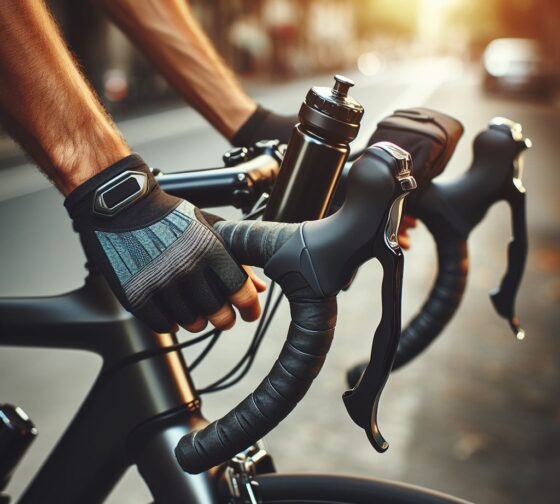Bike Handlebars: Steering Your Cycling Experience
*We may earn a commission for purchases made using our links. Please see our disclosure to learn more.
Bike Handlebars: Your Comprehensive Guide to Choosing the Perfect Fit
Step into the fascinating realm of cycling where the humble handlebars play a pivotal role beyond mere steering. These unassuming components form the very nexus between rider and bike, transcending their functional purpose to become an integral part of your cycling narrative. Embarking on a journey through the diverse landscape of bike handlebars offers a revelation—a fusion of artistry, engineering, and personal synergy. Each handlebar represents an opportunity to fine-tune your ride, where comfort melds seamlessly with control, and individual preferences become the guiding stars of your cycling odyssey.
The handlebars, often understated yet incredibly influential, shape not just the trajectory of your bike, but the essence of your ride. They encapsulate the essence of cycling—a harmonious blend of functionality and personal connection. Join me as we venture deeper into this intricate domain, where every curve, material, and design choice is a canvas upon which your cycling experience is painted. Together, we’ll unravel the tapestry of handlebar choices, discovering how these seemingly simple components are, in fact, the architects of unparalleled riding experiences.
Different Types of Bike Handlebars

- Drop Handlebars: A Classic Choice
- These handlebars are synonymous with road bikes and competitive cycling. Their distinct curved shape offers multiple hand positions, facilitating aerodynamics and speed. The design is tailored for enthusiasts seeking to maximize performance during long rides or races.
- Flat Handlebars: Versatile and Comfortable
- Commonly found on mountain bikes, hybrids, and city cruisers, flat handlebars provide a relaxed, upright riding position. This configuration prioritizes comfort and control, making it an excellent choice for leisure rides and commuting through urban landscapes.
- Riser Handlebars: Elevate Your Comfort
- Riser handlebars offer a subtle rise compared to flat handlebars, promoting a more comfortable and natural riding position. These are favored among trail riders, providing better control and reducing strain, especially on uneven terrains.
- Aero Handlebars: Precision for Speed
- Designed for time trials and triathlons, aero handlebars focus on aerodynamics, allowing cyclists to adopt a more streamlined posture. These handlebars significantly reduce wind resistance, enhancing speed in competitive settings.
Factors to Consider When Choosing Handlebars
Selecting the right handlebars is a personalized process that depends on various factors:
Riding Style and Position
Understanding your riding style is pivotal in determining the ideal handlebar type. Are you a speed-driven road cyclist, an off-road adventurer, or a casual urban commuter seeking comfort?
Comfort and Ergonomics
Ergonomics play a significant role in ensuring a comfortable riding experience. Factors such as handlebar shape, width, grip, and padding contribute to reducing hand fatigue and enhancing overall comfort during long rides.
Material and Weight
The choice of material (aluminum, carbon fiber, steel) influences the handlebar’s weight, durability, and ability to absorb vibrations. Each material presents unique characteristics, and understanding these can help align your preferences with the right handlebar.
Popular Brands and Models
Here are my top three bike handlebar brands known for their quality, innovation, and popularity among cyclists:
- Shimano: Shimano is a renowned brand in the cycling industry, producing a wide range of bike components and accessories, including handlebars. Known for their durability, precision engineering, and diverse selection catering to various riding styles, Shimano handlebars are favored by many cyclists, from enthusiasts to professional riders.
- Specialized: Specialized is recognized for its high-performance bikes and components. Their handlebars are crafted with attention to detail, focusing on ergonomics, lightweight design, and optimal performance. Specialized handlebars come in various shapes and sizes to suit different cycling disciplines, appealing to both casual riders and competitive cyclists.
- FSA (Full Speed Ahead): FSA is a reputable brand offering a broad range of cycling components, including handlebars. Known for their innovation and commitment to producing high-quality products, FSA handlebars often incorporate advanced materials and designs to cater to the demands of cyclists seeking performance and comfort.
Please note that the market dynamics may have changed since my last update, so I recommend checking the latest reviews, user feedback, and professional recommendations to get the most current information regarding top bike handlebar brands in the market.
Benefits of Upgrading Bike Handlebars

Investing in quality handlebars can significantly elevate your cycling experience:
- Enhanced Ergonomics: Well-designed handlebars provide better hand positioning, reducing strain and discomfort.
- Improved Control: The right handlebars offer superior grip and handling, especially during challenging terrains or high-speed rides.
- Reduced Fatigue: Properly chosen handlebars minimize hand and wrist fatigue, allowing for longer and more enjoyable rides.
How to Properly Adjust and Maintain Handlebars
Maintaining handlebars isn’t just about riding but also about regular care and adjustment:
- Routine Checks: Periodically check the alignment and tightness of handlebar components to ensure optimal performance and safety.
- Comfortable Positioning: Adjust the handlebars to your preferred angle and height, aligning them with your body posture for a more comfortable ride.
- Handlebar Tape Replacement: Replace worn-out or damaged handlebar tape to maintain grip and prevent discomfort during rides.
Accessories and Add-ons for Bike Handlebars
Several accessories can complement and customize your handlebars:
- Bar Tape: Available in various materials and designs, bar tape offers not just grip but also aesthetic appeal.
- Grips: Different grips cater to specific preferences, providing comfort and reducing vibration transmission.
- Mirrors and Mounts: Additional accessories like mirrors and mounts enhance functionality, enabling better visibility and convenience.
Advancements in Handlebar Technology
Cycling technology continually evolves, and handlebars have undergone significant advancements to enhance performance and comfort. The integration of carbon fiber, known for its lightweight and robust properties, has revolutionized handlebar construction.
Brands like Easton and Ritchey have introduced carbon fiber handlebars that offer superior strength while dampening road vibrations, providing a smoother and more comfortable ride. These advancements not only reduce the overall weight of the bike but also contribute to improved handling and responsiveness, appealing to cyclists seeking top-tier performance.
Customization Options for Tailored Riding Experiences
Modern handlebars now offer a myriad of customization options, allowing cyclists to fine-tune their riding experiences. Adjustable handlebar stems and various handlebar shapes cater to diverse riding preferences. Brands like Bontrager and PRO provide handlebars with adjustable angles, enabling riders to modify the handlebar’s tilt, creating a more personalized fit.
Additionally, the availability of different widths and ergonomic designs, such as ergonomic drops and flare, enables riders to optimize comfort and control. These customization possibilities empower cyclists to tailor their handlebars to suit individual preferences, ensuring a more enjoyable and efficient ride.
Conclusion
In the diverse world of cycling, handlebars hold a profound significance, serving as the conduit between rider and bike. They’re not merely components but integral companions that dictate comfort, control, and the essence of every ride. Understanding the nuances of handlebars and aligning them with your unique preferences isn’t just about selecting a piece of equipment; it’s about sculpting your cycling journey.
Whether you’re seeking speed, comfort, or adventure, the handlebars you choose will be your trusted allies, guiding you through every pedal stroke. Embrace the variety, explore the options, and discover the perfect handlebars that resonate with your cycling soul. May your handlebars pave the way for countless miles of joyous and memorable cycling adventures!
FAQs About Your Bike Handlebars
- Best handlebars for long-distance cycling?
- Drop handlebars offer multiple hand positions, ideal for long rides, ensuring comfort and reducing fatigue.
- Methods to determine suitable handlebar size?
- Professional fitting services ensure alignment with body posture and riding style.
- Feasibility of switching handlebars on existing bikes?
- Consultation with a bike mechanic ensures compatibility and adjustments for a smooth transition.
- Comparing carbon vs. aluminum handlebars?
- Both materials have merits; choose based on priorities—carbon for vibration damping, aluminum for durability.
- Frequency of replacing handlebar tape?
- Replace when showing signs of wear or tear, typically every 6-12 months based on usage.




